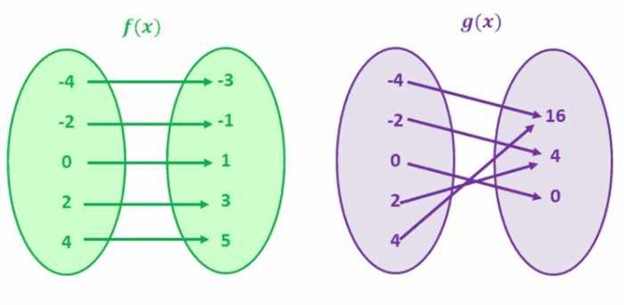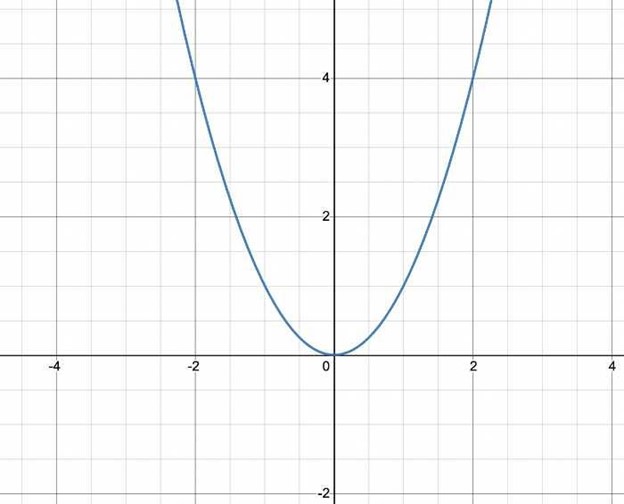One to One Functions - Graph, Examples | Horizontal Line Test
What is a One to One Function?
A one-to-one function is a mathematical function where each input correlates to just one output. So, for every x, there is just one y and vice versa. This signifies that the graph of a one-to-one function will never intersect.
The input value in a one-to-one function is known as the domain of the function, and the output value is the range of the function.
Let's study the images below:

For f(x), each value in the left circle corresponds to a unique value in the right circle. In the same manner, any value on the right side correlates to a unique value on the left. In mathematical words, this implies every domain holds a unique range, and every range has a unique domain. Hence, this is an example of a one-to-one function.
Here are some additional representations of one-to-one functions:
-
f(x) = x + 1
-
f(x) = 2x
Now let's examine the second example, which displays the values for g(x).
Be aware of the fact that the inputs in the left circle (domain) do not have unique outputs in the right circle (range). For instance, the inputs -2 and 2 have the same output, in other words, 4. In conjunction, the inputs -4 and 4 have the same output, i.e., 16. We can comprehend that there are matching Y values for multiple X values. Hence, this is not a one-to-one function.
Here are different representations of non one-to-one functions:
-
f(x) = x^2
-
f(x)=(x+2)^2
What are the characteristics of One to One Functions?
One-to-one functions have the following qualities:
-
The function has an inverse.
-
The graph of the function is a line that does not intersect itself.
-
It passes the horizontal line test.
-
The graph of a function and its inverse are the same regarding the line y = x.
How to Graph a One to One Function
In order to graph a one-to-one function, you are required to figure out the domain and range for the function. Let's study a straight-forward example of a function f(x) = x + 1.

Immediately after you have the domain and the range for the function, you have to plot the domain values on the X-axis and range values on the Y-axis.
How can you tell whether or not a Function is One to One?
To indicate whether a function is one-to-one, we can apply the horizontal line test. As soon as you chart the graph of a function, trace horizontal lines over the graph. If a horizontal line intersects the graph of the function at more than one place, then the function is not one-to-one.
Due to the fact that the graph of every linear function is a straight line, and a horizontal line does not intersect the graph at more than one spot, we can also conclude all linear functions are one-to-one functions. Don’t forget that we do not leverage the vertical line test for one-to-one functions.
Let's study the graph for f(x) = x + 1. Immediately after you chart the values for the x-coordinates and y-coordinates, you have to examine whether a horizontal line intersects the graph at more than one point. In this case, the graph does not intersect any horizontal line more than once. This signifies that the function is a one-to-one function.

On the other hand, if the function is not a one-to-one function, it will intersect the same horizontal line more than once. Let's examine the figure for the f(y) = y^2. Here are the domain and the range values for the function:

Here is the graph for the function:

In this instance, the graph intersects multiple horizontal lines. For instance, for both domains -1 and 1, the range is 1. Additionally, for both -2 and 2, the range is 4. This implies that f(x) = x^2 is not a one-to-one function.
What is the opposite of a One-to-One Function?
As a one-to-one function has only one input value for each output value, the inverse of a one-to-one function also happens to be a one-to-one function. The opposite of the function basically reverses the function.
For Instance, in the case of f(x) = x + 1, we add 1 to each value of x for the purpose of getting the output, in other words, y. The inverse of this function will remove 1 from each value of y.
The inverse of the function is denoted as f−1.
What are the properties of the inverse of a One to One Function?
The qualities of an inverse one-to-one function are no different than all other one-to-one functions. This means that the reverse of a one-to-one function will hold one domain for every range and pass the horizontal line test.
How do you figure out the inverse of a One-to-One Function?
Figuring out the inverse of a function is simple. You simply need to swap the x and y values. For instance, the inverse of the function f(x) = x + 5 is f-1(x) = x - 5.

As we learned previously, the inverse of a one-to-one function undoes the function. Because the original output value required us to add 5 to each input value, the new output value will require us to delete 5 from each input value.
One to One Function Practice Questions
Consider these functions:
-
f(x) = x + 1
-
f(x) = 2x
-
f(x) = x2
-
f(x) = 3x - 2
-
f(x) = |x|
-
g(x) = 2x + 1
-
h(x) = x/2 - 1
-
j(x) = √x
-
k(x) = (x + 2)/(x - 2)
-
l(x) = 3√x
-
m(x) = 5 - x
For any of these functions:
1. Figure out whether or not the function is one-to-one.
2. Graph the function and its inverse.
3. Figure out the inverse of the function numerically.
4. State the domain and range of both the function and its inverse.
5. Apply the inverse to solve for x in each equation.
Grade Potential Can Help You Master You Functions
If you are having problems trying to learn one-to-one functions or similar topics, Grade Potential can set you up with a 1:1 instructor who can assist you. Our Kent math tutors are skilled professionals who assist students just like you enhance their understanding of these concepts.
With Grade Potential, you can learn at your own pace from the convenience of your own home. Schedule a call with Grade Potential today by calling (330) 590-5311 to get informed about our teaching services. One of our consultants will call you to better inquire about your requirements to find the best instructor for you!




